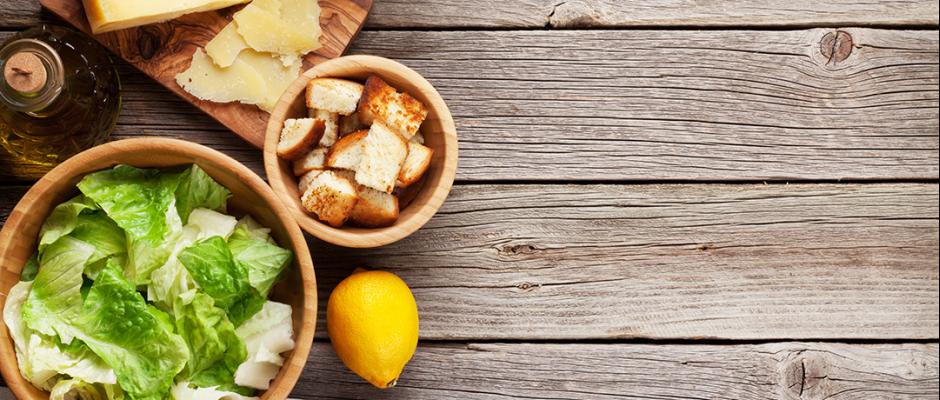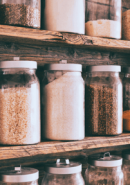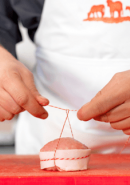Most people assume the Caesar salad was named after Julius Caesar or the Caesar family who ruled Rome. In fact, the Caesar salad was invented in Tijuana Mexico by a man named Caesar Cardini, an Italian –American restaurateur. Legend has it that Cardini owned a restaurant to attract Americans during the prohibition era, and on July 4th 1924, a rush of diners strained the kitchen resources for food, so Cardini grabbed whatever ingredients he had on hand an improvised a table side made salad.
The original recipe included romaine lettuce, garlic, croutons, Parmesan cheese, boiled eggs, olive oil and Worcestershire sauce. Anchovies were not introduced to the recipe until 1926 when his brother came to Tijuana and tweaked the recipe a bit. Newer still versions added lemon juice. Never the less the salad grew to one of the most popular dishes of the time. In 1953, the International Society of Epicure declared the classic salad, which by then was popular in Europe, “the greatest recipe to originate from the Americas in 50 years.” In Julia Child cookbook, From Julia Child’s Kitchen, Child recounted traveling to Tijuana with her family: “My parents, of course, ordered the salad. Caesar himself rolled the big cart up to the table, tossed the romaine in a great wooden bowl, and I wish I could say I remembered his every move, but I don’t. They only thing I see again clearly is the eggs. I can see him break 2 eggs over that romaine and roll them in, the greens going all creamy as the eggs flowed over them. Two eggs in a salad? Two one-minute coddled eggs? And garlic-flavored croutons, and grated Parmesan cheese? It was a sensation of a salad from coast to coast, and there were even rumblings of its success in Europe.”
Well my memories of Caesar salad may not have been that worldly, but they remain one of my fondest food memories growing up today. I learned 9 years old how to make his perfect tableside Caesar salad from my father (also an Italian American). I was fortunate enough to grow up in a family were food was important and mealtime was a gathering. Every night our family sat around the table and ate and talked about our day and shared our school grades (if they were good). Mom and dad would talk about their work as we passed around dinner rolls, cuts of roast chicken and overcooked string beans. But the treat of the night is when we saw my dad pull out a large wooden salad bowl from the lower cupboard. It was the only bowl used for this salad and nothing else was prepared in that bowl. Like the popularity of this salad being served table side, my dad would bring it to the table with all the ingredients and make this a fun, hands on, interactive treat at dinner time. Both my sister and I would fight over who got to squeeze the lemon juice and who got to whisk the dressing. My dad always said the same thing to us each time he made the salad. He revered his secrete was how he diligently rubbed the raw garlic cloves all over the inner surface of the bowl. He would not allow any one of us to do this task, it was his perfected way of knowing how gentle to rub the bowl and just how much garlic to use. He would then crack a coddled egg in the middle of the bowl, add Dijon mustard, and capers (our family did not like anchovies or Worcestershire, but loved the salty briny addition that capers added to the dressing). I would squeeze a little lemon juice in my father drizzled some olive oil and my sister would whisk it all together. In the end, we grated some Parmesan cheese into it and tossed by hand cut romaine. The piece de resistance was the skillet sautéed croutons, crispy with butter salt and a little spice. This was Caesar salad at my house and we had it often.
Many years later during one of my classes in The French Culinary Institute, we learned the classic method of making traditional Caesar dressing, very much similar to the recipes explained above. But no matter how many times we would make it, or how many times I would have it in a restaurant, it never tasted like my dad’s. Was it the highly regarded wooden bowl, was it the way he delicately rubbed the garlic into the bowl, was it that it was an interactive food memory of mine. It didn’t matter, Caesar salad has remained one of my most coveted fondest food memories of all time.
The classic Caesar salad is not only one of the world’s biggest food treasure, but it is a recipe that has been and continues to evolve, adapt, deconstruct and be newly improvised. The dressing itself is so versatile and has such powerful flavor that it can be used in many new applications. I encourage you to make Caesar dressing and try it in many different ways. Try grilling wedges of romaine and radicchio to get a nice quick smoky char before dressing this fork and knife salad with the Caesar dressing. Try massaging the dressing into chopped garden kale and add toasted chic peas and roasted squash for a hearty salad. I love making a charred broccoli salad and toss it in fresh made Caesar dressing. The dressing is also versatile as a marinade. Try brushing the dressing over a whole salmon before broiling it to medium rare. Serve with a mixed herb salad dressed simply with lemon and olive oil. As Caesar Cardini did back in 1924, improvise with these ingredients and maybe your new recipe will be declared the best of our time.
Barnette, Martha. Ladyfingers and Nun’s Tummies.
New York: Vintage Books, 1997. ISBN 0-8129-2100-3 (pp. 94-95).
Whats cooking America




